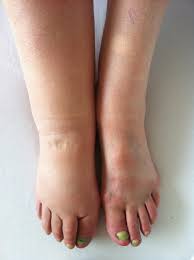Lymphoedema is a swelling of the lower limbs due to a problem with the lymphatic drainage.
Lymphedema is a chronic condition characterized by the accumulation of lymph fluid in the tissues, leading to swelling, usually in the arms or legs. It occurs when there is a disruption in the normal flow of lymphatic fluid, which can happen due to a variety of reasons, including:
- Primary Lymphedema: This type of lymphedema is caused by congenital malformation or abnormalities in the lymphatic system. It is relatively rare and often develops later in life.
- Secondary Lymphedema: This type of lymphedema is more common and typically occurs as a result of damage to the lymphatic system. The damage can be due to various factors, including surgery, radiation therapy, infection, trauma, or cancer.
The symptoms of lymphedema include:
- Persistent swelling in the affected limb (arm or leg).
- A feeling of heaviness or tightness in the limb.
- Reduced flexibility and range of motion in the affected limb.
- Thickening and hardening of the skin (fibrosis) in advanced cases.
- Recurring infections or cellulitis in the affected area.
- Discomfort or pain in the affected limb.
Lymphedema is a chronic condition that requires ongoing management. While there is no cure for lymphedema, various treatment approaches can help manage and control the swelling. These may include:
- Manual Lymphatic Drainage (MLD): This is a specialized massage technique performed by trained therapists to stimulate the flow of lymph fluid and reduce swelling.
- Compression Therapy: The use of compression garments or bandages can help support the affected limb, improve lymphatic flow, and prevent fluid buildup.
- Exercise: Gentle, low-impact exercises can help promote lymphatic flow, improve muscle strength, and reduce swelling.
- Skin Care: Proper skin hygiene and care are essential to prevent infections and manage any skin changes associated with lymphedema.
- Complete Decongestive Therapy (CDT): CDT is a comprehensive treatment program that combines various components, including MLD, compression therapy, exercise, and skin care, to manage lymphedema effectively.
- Surgery: In severe cases of lymphedema that are unresponsive to conservative treatments, surgical interventions such as lymphatic bypass or lymph node transfer may be considered.
It’s important for individuals with lymphedema to work closely with a healthcare team specializing in lymphedema management. They can provide personalized guidance, develop an appropriate treatment plan, and offer education and support to help individuals manage their condition effectively and improve their quality of life.

